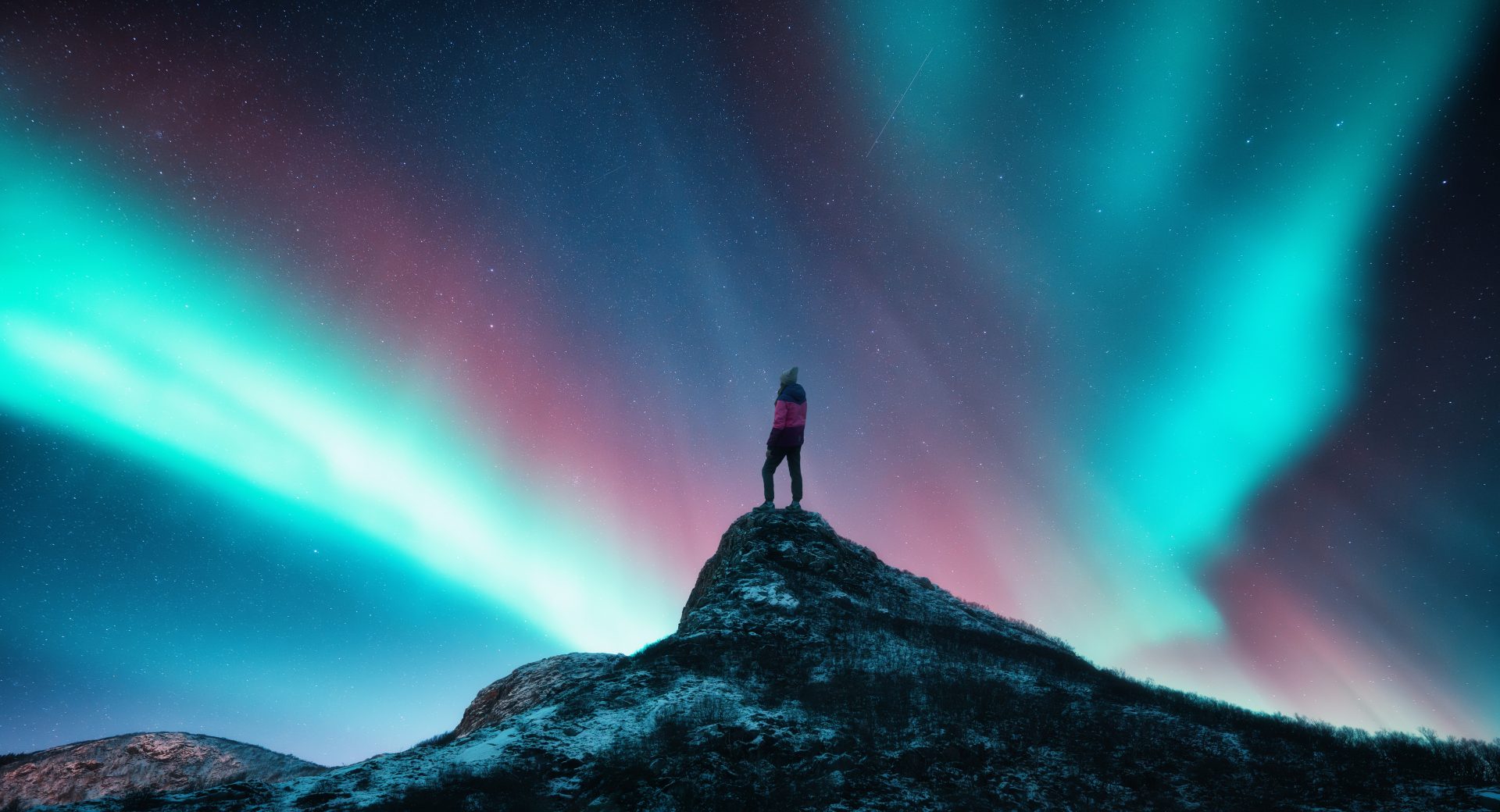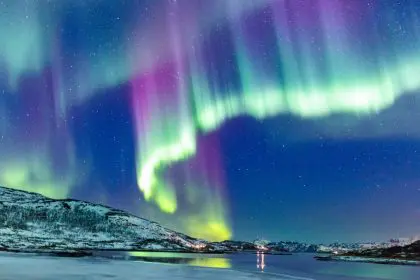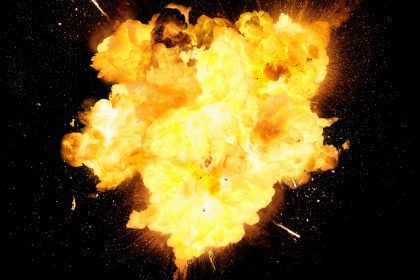Millions of Americans across northern regions may witness one of nature’s most spectacular displays as the National Oceanic and Atmospheric Administration forecasts Northern Lights visibility across 13 states during Monday evening through Tuesday morning. The aurora viewing opportunity results from a G1 geomagnetic storm prediction that could illuminate skies from Washington to Maine with dancing curtains of colored light.
The forecast comes following an extreme G5 geomagnetic storm the previous weekend that produced aurora displays as far south as California, demonstrating the current heightened solar activity affecting Earth’s magnetic environment. As the summer solstice approaches on June 21, atmospheric conditions and geographic positioning make the United States particularly favorable for aurora observations during this period.
Geographic coverage spans northern tier states
The potential aurora display encompasses a broad swath of northern states positioned along or near the Canadian border, where magnetic field interactions create optimal viewing conditions. Washington state anchors the western extent of the viewing zone, while Maine represents the eastern boundary of the predicted visibility area.
States included in the forecast zone comprise Washington, northern Idaho, Montana, northeast Wyoming, North Dakota, South Dakota, Minnesota, Wisconsin, Michigan, New York, Vermont, New Hampshire, and Maine. The geographic distribution reflects the typical southward extension of the auroral oval during moderate geomagnetic disturbances.
Regions closest to the Canadian border maintain the highest probability of successful aurora viewing, as the magnetic field lines concentrate charged particle interactions in these northernmost areas. Urban areas within the forecast zone may experience reduced visibility due to light pollution, making rural locations preferable for optimal viewing experiences.
Storm intensity determines viewing quality
The forecasted G1 geomagnetic storm represents moderate magnetic disturbance levels on the five-point scale used to measure space weather impacts. While less intense than the recent G5 extreme storm, G1 conditions can still produce visible aurora displays across significant geographic areas when atmospheric conditions cooperate.
NOAA’s Kp index, which measures auroral activity intensity, may reach level 5 during the forecast period, indicating enhanced auroral displays with increased brightness and movement. This intensity level typically produces aurora visible to the naked eye in dark sky locations within the predicted viewing zone.
The Kp 5 intensity represents a significant increase from typical background levels, creating conditions where aurora displays become more dynamic with enhanced colors and formations. Viewers in optimal locations may observe the characteristic green curtains along with possible red and purple coloration at higher altitudes.
Timing requires real-time monitoring
While the general forecast covers Monday night through Tuesday morning, precise timing and intensity of aurora displays depend on real-time solar wind measurements from spacecraft positioned between Earth and the sun. NASA’s DSCOVR and ACE satellites provide approximately 30-minute advance warning when solar wind conditions favor aurora development.
These spacecraft monitor solar wind speed and magnetic field orientation, with southward-pointing magnetic fields creating optimal conditions for geomagnetic disturbances. The satellite data feeds into updated forecasting models that refine predictions as conditions develop.
Aurora enthusiasts should monitor NOAA’s 30-minute forecast updates or utilize specialized applications like the Glendale App for current conditions and visibility predictions. The dynamic nature of space weather means that aurora displays can develop rapidly or dissipate quickly based on changing solar wind conditions.
Solar maximum period enhances activity
Current aurora activity occurs within the context of solar maximum, the peak period of the sun’s 11-year activity cycle when sunspot numbers and solar flares reach elevated levels. The present solar maximum represents a 23-year high in solar activity, creating frequent opportunities for geomagnetic disturbances and aurora displays.
Solar maximum conditions typically persist for several years, with current predictions indicating continued enhanced activity through 2025 and 2026. This extended period of heightened solar activity increases the frequency of geomagnetic storms and expands aurora visibility to lower latitudes than typically observed.
The increased solar activity results from complex magnetic field interactions on the sun’s surface that produce coronal mass ejections and enhanced solar wind streams. These phenomena create the space weather conditions necessary for aurora displays when they interact with Earth’s magnetic field.
Scientific explanation reveals natural mechanics
Aurora displays result from interactions between solar wind particles and Earth’s magnetic field system, creating one of the most visible manifestations of space weather phenomena. The solar wind consists of charged particles streaming continuously from the sun at speeds typically ranging from 300 to 800 kilometers per second.
Earth’s magnetic field deflects most solar wind particles, but some become trapped and accelerated along magnetic field lines toward the polar regions. These particles collide with oxygen and nitrogen atoms in the upper atmosphere, exciting them and causing the release of energy as visible light.
Different atmospheric gases produce distinct colors when excited by charged particle collisions. Oxygen typically creates green and red emissions, while nitrogen contributes blue and purple hues. The altitude of these interactions influences color intensity and distribution within aurora displays.
Photography techniques capture memorable images
Modern smartphone cameras equipped with night mode capabilities can successfully capture aurora displays, providing accessible photography options for casual observers. Night mode typically employs longer exposure times of five to 10 seconds, allowing cameras to collect sufficient light for detailed aurora images.
Successful aurora photography requires camera stability to prevent motion blur during extended exposures. Smartphone tripods or stable surfaces like fence posts or vehicle roofs provide the necessary support for sharp images. Using the primary camera lens rather than wide-angle options typically produces superior image quality.
Shooting in raw format, when available, provides greater flexibility for post-processing adjustments to enhance aurora colors and contrast. Basic editing applications can significantly improve aurora photographs by adjusting exposure, contrast, and color saturation to better represent the visual experience.
Historical context provides perspective
The recent G5 geomagnetic storm that produced aurora displays as far south as Florida represents the most intense geomagnetic activity since 2003, demonstrating the exceptional nature of current space weather conditions. Such extreme events occur infrequently, making moderate storms like the current G1 forecast more typical of enhanced aurora activity.
Historical records show that significant aurora displays visible at mid-latitudes occur several times per decade during solar maximum periods, with the frequency depending on solar cycle intensity. The current solar maximum appears particularly robust, creating multiple opportunities for aurora viewing across northern United States.
Long-term climate and space weather patterns suggest that aurora viewing opportunities will continue throughout the current solar maximum period, providing multiple chances for observers to witness these natural light displays during favorable conditions and clear skies.
Preparation enhances viewing success
Successful aurora viewing requires dark sky locations away from urban light pollution, with northern horizon visibility being particularly important for observers at southern edges of the forecast zone. Rural areas, state parks, and elevated locations typically provide optimal viewing conditions.
Weather conditions significantly impact aurora visibility, with clear skies being essential for successful observations. Cloud cover can completely obscure aurora displays, making weather forecasts an important consideration for planning viewing sessions.
Patience often proves necessary for aurora viewing, as displays can develop slowly or occur in intermittent bursts rather than continuous shows. Comfortable outdoor clothing and seating arrangements enhance the viewing experience during potentially lengthy observation periods.
Community engagement opportunities emerge
Aurora forecasts often generate increased interest in astronomy and space science education, creating opportunities for community groups, schools, and science centers to organize viewing events and educational programs. These gatherings can enhance public understanding of space weather phenomena and Earth’s magnetic field system.
Social media platforms frequently showcase aurora photography during active periods, creating virtual communities of aurora enthusiasts who share viewing experiences and photography techniques. These online interactions can provide real-time updates on aurora activity and viewing conditions across different locations.
Local astronomy clubs and weather services often provide aurora viewing guidance and organize group observations during forecast periods, offering educational opportunities and shared experiences for community members interested in natural phenomena.
The forecasted Northern Lights display represents an accessible opportunity for millions of Americans to witness one of nature’s most spectacular phenomena while contributing to greater public awareness and appreciation of space weather science and Earth’s complex magnetic environment systems.














